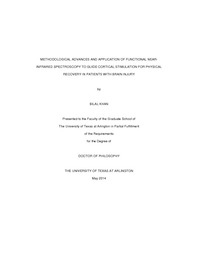
ATTENTION: The works hosted here are being migrated to a new repository that will consolidate resources, improve discoverability, and better show UTA's research impact on the global community. We will update authors as the migration progresses. Please see MavMatrix for more information.
Show simple item record
| dc.contributor.author | Khan, Bilal | |
| dc.date.accessioned | 2017-05-31T19:24:07Z | |
| dc.date.available | 2017-05-31T19:24:07Z | |
| dc.date.submitted | January 2014 | |
| dc.identifier.other | DISS-12672 | |
| dc.identifier.uri | http://hdl.handle.net/10106/26683 | |
| dc.description.abstract | Non-invasive cortical stimulation used in conjunction with physical therapy can enhance the motor performance of persons with brain injury. Transcranial direct current stimulation (tDCS) is a non-invasive cortical stimulation technique that modulates cortical activation by delivering weak current through a pair of anodal-cathodal (excitation-suppression) electrodes, placed on the scalp over the targeted cortical centers. Recently, application of tDCS over the sensorimotor cortex of stroke patients in conjunction with physical therapy has been shown to induce beneficial plasticity in the injured brain resulting in improved motor performance. However, in all currently reported tDCS-based interventions the locations of electrode pairs used to apply stimulation are kept the same across all patients without taking into account individual differences in their residual sensorimotor networks. The resulting study outcomes remain variable and there is no current consensus as to what electrode pair montage could yield optimal outcomes. These observations indicate the possibility that no single electrode pair montage exists that is optimal for all patients and that a method capable of personalize tDCS electrode placement could be very helpful for improving therapy outcomes. The objective of this work was to propose and test a new non-invasive cortical stimulation method based on the tDCS principle that could identify the electrode montage maximizing the performance of a given motor task in each subject and thus potentially personalize future treatments. Functional near-infrared spectroscopy (fNIRS) was used as a means of assessing the effects of stimulation on cortical function. Though fNIRS can only measure activation related changes in cortical hemodynamics, it can acquire data concurrently with electrical stimulation, which is not possible with functional magnetic resonance imaging (fMRI) due to electrical interference. Arm muscle activation and motor performance were recorded synchronously with fNIRS during an isometric wrist-flexion task, so as to enable the study of how changes in cortical activation lead to changes in arm muscle activity and subsequent motor performance. The road towards developing this new method for tDCS treatment personalization involved the three following steps:1) Development of a novel fNIRS hardware attachment that we call the brush optode that enabled performing measurements on all subjects, irrespective of high hair densities and dark hair colors, thus resolved this long-standing optical contact problem in the fNIRS field.2) Development and testing of a method to simultaneously measure fNIRS, muscle activity, and arm performance before, during, and after tDCS. The findings of this work demonstrated that tDCS produced cortical perturbations that are measurable with fNIRS. Furthermore, fNIRS produced cortical connectivity maps that helped explain how stimulation-induced changes in the cortex resulted in changes of muscle activity output and arm performance.3) Based on the groundwork performed in Step 2 a novel perturbation tDCS (ptDCS) paradigm was developed for determining a personalized electrode montage with which a subsequent tDCS intervention yields maximal motor task performance improvements during and immediately after stimulation. Unexpected and surprising results were found for the tDCS electrode montage maximizing the performance of an isometric wrist flexion task performed by a group of ten healthy adults, as this optimal montage did not match any of the ones being explored in current literature as a means of improving the motor performance of patients. Furthermore, in five hemiparetic stroke patients measured with this ptDCS the optimal electrode montage was found to be different in each patient.The findings from this newly developed ptDCS method present a paradigm shift in current practices as they indicate that not all patients benefit from the same stimulation montage. Rather than treating all patients uniformly, personalization of treatment may be a preferable route for improving therapy outcomes. The above findings are very exciting due to the potential generalized application of the ptDCS method to many other types of brain injury and to the possible performance enhancement of healthy adults. Nevertheless, clinical studies employing ptDCS-guided tDCS treatment, combined with physical therapy where appropriate, would need to be performed in the future to confirm the potential of this method. | |
| dc.description.sponsorship | Alexandrakis, George | |
| dc.language.iso | en | |
| dc.publisher | Biomedical Engineering | |
| dc.title | Methodological Advances And Application Of Functional Near-infrared Spectroscopy To Guide Cortical Stimulation For Physical Recovery In Patients With Brain Injury | |
| dc.type | Ph.D. | |
| dc.contributor.committeeChair | Alexandrakis, Georgios | |
| dc.degree.department | Biomedical Engineering | |
| dc.degree.discipline | Biomedical Engineering | |
| dc.degree.grantor | University of Texas at Arlington | |
| dc.degree.level | doctoral | |
| dc.degree.name | Ph.D. | |
Files in this item
- Name:
- Khan_uta_2502D_12672.pdf
- Size:
- 9.273Mb
- Format:
- PDF
This item appears in the following Collection(s)
Show simple item record


